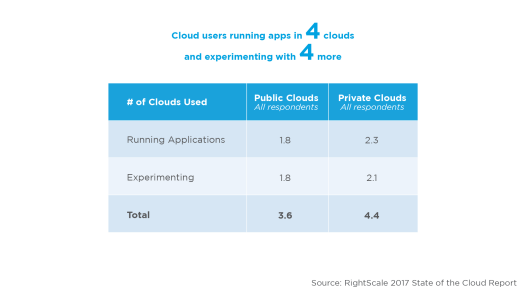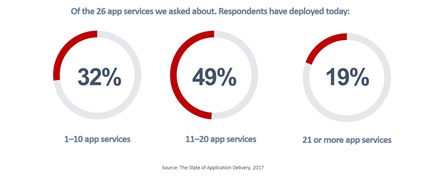멀티 클라우드 전략에는 멀티 클라우드 솔루션이 필요합니다.
(적어도 제 생각에는) 기업 조직의 새로운 표준 운영 모델이 주로 클라우드 기반이라는 점에는 의심의 여지가 거의 없습니다. 저는 "클라우드"라는 용어를 개인(온프레미스) 및 공공(오프프레미스) 클라우드 모델 모두를 포괄하는 넓은 의미로 사용합니다. 모든 징후가 가까운 미래에 두 모델이 모두 사용될 것임을 가리키고 있기 때문입니다.
어떤 경우에는 둘 다 혼합된 형태, 즉 하나의 퍼블릭 클라우드와 다른 퍼블릭 클라우드를 적어도 하나(어쩌면 그 이상)의 프라이빗 클라우드 옵션에 대해 경쟁시키는 형태를 의미합니다.
각 모델이 조직의 전략을 구성하는 개수와 관계없이, 실제로는 여러 클라우드에 애플리케이션을 배포할 가능성이 높습니다. 즉, 멀티클라우드입니다. 그에 대한 좋은 이유는 여러 가지 있지만 오늘의 논의와는 관련이 없습니다. 말할 것도 없이 조직들은 " 멀티 클라우드 " 전략을 채택하고 있을 가능성이 높습니다. 더 이상 말할 필요도 없습니다.

하지만 그것은 매우 큰 의미를 갖습니다. 데이비드 린티컴클라우드 해설가이자 뛰어난 전문가인 그는 최근 기사에서 이러한 유형의 전략이 DevOps 이니셔티브에 미치는 영향을 언급했습니다.
1. Devops에 하이브리드 솔루션이 필요합니다. 오늘날의 퍼블릭 클라우드는 Devops에 대한 원스톱 쇼핑을 제공하지 않습니다. DevOps 지원을 포함한 애플리케이션 개발 관리 기능이 있지만, 여전히 퍼블릭 클라우드 서비스와 기존 소프트웨어를 포함한 여러 제품을 조합하여 솔루션을 만들어야 하는 세상입니다.
Devops 툴체인 의 필요성을 넘어 확장하면, 여러 클라우드에서 앱을 실행하는 경우 앱을 사용자에게 제공하려고 하기 때문에 이를 인식하는 것이 중요합니다. 내부, 외부, 파트너. 사람, 사물, API. 사용자가 누구이든(또는 무엇이든) 상관없이, 일반적으로 앱을 배포할 때는 비즈니스 목적으로 사용할 목적으로 사용해야 한다는 사실은 변함이 없습니다. 즉, 앱은 필요한 사람(또는 대상)에게 제공되어야 합니다.
앱을 제공하려면 서비스가 필요합니다. 규모를 위한 간단한 로드 밸런싱이든 최신 기즈모나 가젯을 위한 IoT 보안 서비스이든, 궁극적으로 앱을 의도한 대상에게 안전하게 전송하는 것을 보장하는 수많은 앱 서비스가 있습니다. 멀티 클라우드 모델에서 운영한다고 가정하면 DevOps와 동일한 문제가 발생할 것입니다. 모든 클라우드가 동일한 서비스를 제공하는 것은 아니며, 기본 서비스는 다른 클라우드의 서비스와 호환되지 않을 가능성이 거의 확실합니다. 클라우드 제공업체로부터 일부 서비스를 받을 수 있지만, 다른 서비스는 그대로 유지되며 이를 배포하려면 다른 소스가 필요합니다.

2017년 애플리케이션 제공 현황 보고서에서 오늘날 조직에서 사용하는 앱 서비스 수를 살펴보면, 대부분의 조직이 11~20개의 앱 서비스를 사용한다는 것을 알 수 있습니다. 이는 매우 많은 서비스이며, 가용성, 성능, 보안, ID, 이동성이라는 5가지 범주로 구분되어 있습니다.
즉, 여러 클라우드 공급자에 분산된 다양한 서비스(클라우드 네이티브 및 기타)를 효율적으로 관리할 방법이 없고, 최상의 애플리케이션 경험을 보장하는 데 필요한 가시성을 제공하는 기능을 활용할 방법도 없는 상황이 될 가능성이 높습니다.
데이비드가 간결하게 표현했듯이, "퍼블릭 클라우드 서비스를 포함한 여러 제품을 조합하여 솔루션을 조립"해야 하며, 이 경우 보다 전통적으로 제공되는 앱 서비스를 조립해야 합니다. 비효율적이며, 설문 조사에 따르면 멀티 클라우드 전략을 갖춘 조직에게는 어려운 문제입니다.
그러므로 멀티 클라우드 전략을 실행하기로 결정했다면 해당 전략의 영향을 받는 다른 모든 전략을 주의 깊게 살펴보는 것이 중요합니다. DevOps는 하나이고 앱 서비스도 또 하나입니다. 멀티 클라우드 앱 서비스 전략은 원하는 각각의 클라우드 환경에 필요한 앱 서비스를 배포하는 것 이상을 의미합니다. 클라우드의 이점을 실현하려면 새로운 운영 모델을 구성하는 퍼블릭 클라우드에서 가시성과 정책 준수를 잃지 않도록 가능한 한 일관된 방식으로 해당 서비스를 관리할 수 있는지 확인하는 것도 중요합니다.
멀티 클라우드 전략이 아직은 "표준"이 아닐 수도 있지만 모든 징후는 그것이 될 것이라고 말하고 있습니다. 상당수의 기업이 이미 프라이빗 클라우드에 투자했으며, 이제 많은 기업이 역량을 확장하고 그 이점을 실현하기 위해 퍼블릭 클라우드로 눈을 돌리고 있습니다. 하지만 이러한 이점은 애플리케이션의 안전한 전달을 보장하는 데 필요한 일관된 관리 및 정책을 효과적으로 제공할 수 없는 비효율적인 솔루션으로 인해 쉽게 사라질 수 있습니다.
멀티 클라우드 전략에는 멀티 클라우드 솔루션이 필요하며, 여기에는 안전하고 만족스러운 애플리케이션 경험을 제공하는 데 매우 중요한 앱 서비스가 포함됩니다.
